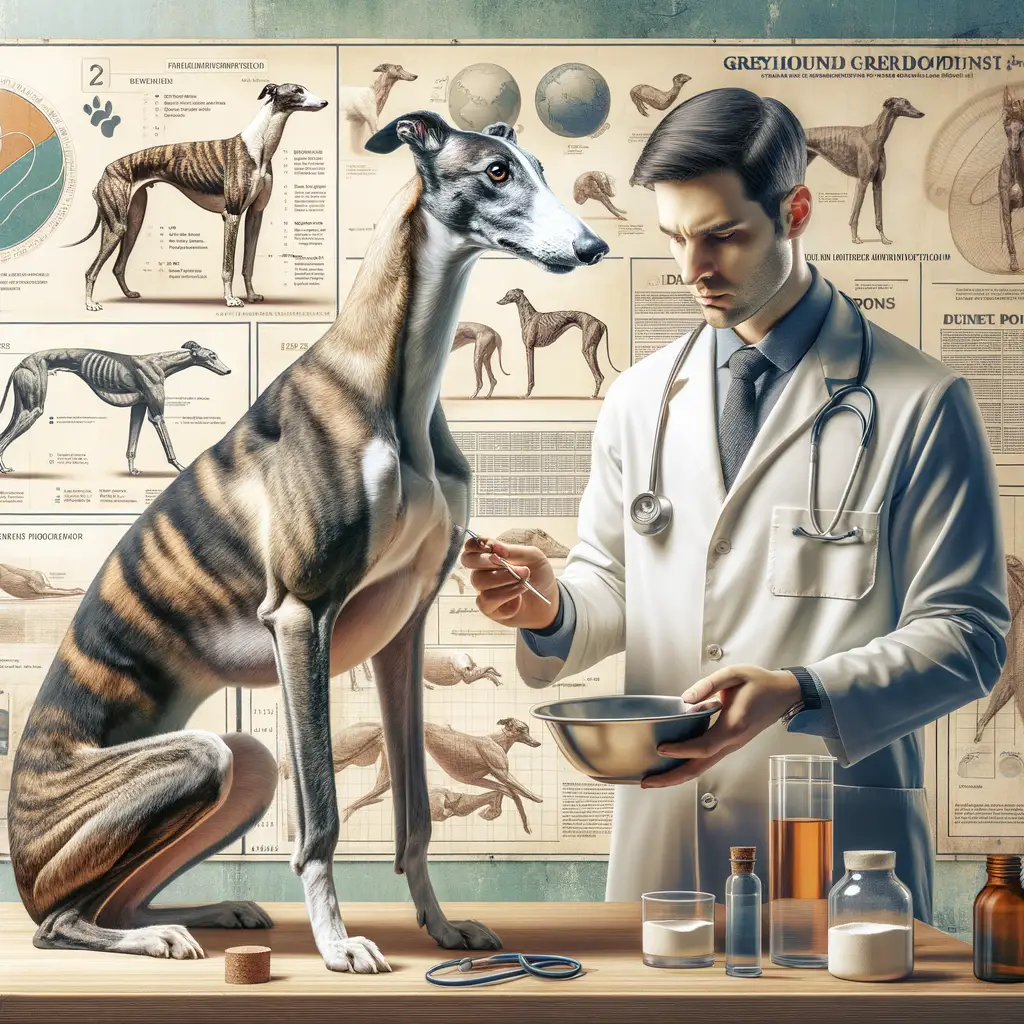
Introduction to Greyhound Care
Greyhounds are known for their speed, elegance, and kind-hearted nature. They are a unique breed that requires special care and understanding. This guide will help you understand the Greyhound breed, why they are considered majestic dogs, and the role you play as their guardian.
- Understanding the Greyhound breed
- Why Greyhounds are considered majestic dogs
- The role of Greyhound guardians
Greyhounds are one of the oldest dog breeds, with their history tracing back over 4000 years to ancient Egypt. They are known for their incredible speed and agility, often reaching up to 45 miles per hour in a sprint. Despite their athletic nature, Greyhounds are surprisingly low-energy dogs, often referred to as “45-mph couch potatoes”. They are gentle, affectionate, and enjoy the company of their human companions.
Greyhounds are often seen as majestic due to their sleek, streamlined bodies and graceful movements. Their long, slender legs and deep chest contribute to their unique, elegant appearance. They carry themselves with a quiet dignity that is hard to ignore. Their calm and gentle demeanor, combined with their athletic prowess, make them truly majestic creatures.
As a Greyhound guardian, your role is to provide a safe, comfortable environment for your dog. This includes regular exercise, a balanced diet, and lots of love and attention. Greyhounds are sensitive dogs that thrive on human companionship. They require a gentle touch and understanding. As their guardian, it’s your responsibility to ensure they are well cared for and loved.
In conclusion, caring for a Greyhound is a rewarding experience that requires understanding and patience. These majestic dogs have unique needs and characteristics that make them stand out from other breeds. As their guardian, you have the opportunity to provide them with the love and care they deserve.
Adopting Greyhounds: Things to Know
Adopting a greyhound can be a rewarding experience, but it’s important to be prepared. Here are some key points to consider.
- Understanding the Adoption Process
- Preparing Your Home for a Greyhound
- Adopting vs Buying a Greyhound
Adopting a greyhound is not as simple as just picking one out and bringing it home. Most adoption agencies have a thorough process to ensure that each dog is placed in a suitable home. This usually involves an application, an interview, and a home visit. The process can take several weeks, so patience is key.
Greyhounds are unique dogs with specific needs. They are large, but surprisingly, they don’t need a lot of space. They are quite comfortable in small apartments as long as they get regular exercise. However, they do need a soft bed, as they have thin skin and can get pressure sores easily. Also, they are sensitive to cold, so a warm coat for winter walks is a must.
While buying a greyhound from a breeder might seem like the easier option, adopting one has many benefits. Adopted greyhounds are usually retired racing dogs, which means they are already trained and socialized. Plus, by adopting, you are giving a second chance to a dog that might otherwise be euthanized.
| Adoption Process | Preparing Your Home | Adopting vs Buying |
|---|---|---|
| Application, interview, and home visit | Soft bed, regular exercise, warm coat | Adopted greyhounds are trained and socialized |
In conclusion, adopting a greyhound requires preparation and commitment, but the rewards are immeasurable. Not only will you be giving a loving home to a dog in need, but you’ll also be gaining a loyal and affectionate companion.
Greyhound Breed Information
Greyhounds are a unique breed with a rich history and distinct physical characteristics. Let’s delve into the specifics of their physical traits.
Physical Characteristics of Greyhounds
Greyhounds are known for their sleek, athletic build and swift speed. But there’s more to their physical characteristics than just that. Let’s explore in detail.
- Size and Weight
- Coat and Color
- Life Expectancy
Greyhounds are a large breed. Adult males typically stand between 28 and 30 inches tall at the shoulder and weigh between 65 and 85 pounds. Females are slightly smaller, usually standing between 27 and 28 inches tall and weighing between 60 and 75 pounds.
Greyhounds have a short, smooth coat that’s easy to maintain. They come in a variety of colors, including black, white, red, blue, fawn, brindle, and combinations of these colors. Despite their name, grey is just one of many possible coat colors for this breed.
Greyhounds have a relatively long lifespan for a large breed. On average, they live between 10 and 14 years. With proper care and regular veterinary check-ups, some greyhounds have been known to live even longer.
In conclusion, Greyhounds are a large, athletic breed with a short, easy-to-care-for coat and a longer-than-average lifespan for dogs of their size. Their unique physical characteristics are part of what makes them such a beloved breed.
Temperament of Greyhounds
Greyhounds are known for their unique temperament that sets them apart from other dog breeds. Let’s delve into the specifics of their behavior, socialization needs, and exercise requirements.
- Behavioral Traits
- Socialization Needs
- Exercise Requirements
Greyhounds are often described as gentle and affectionate dogs. They are known for their calm demeanor and are usually very friendly with their human companions. Despite their racing background, Greyhounds are surprisingly laid-back and enjoy relaxing. They are intelligent and can be trained easily, but they can also be a bit stubborn at times. It’s important to remember that every Greyhound is an individual and may not display all these traits.
Socialization is crucial for Greyhounds. They are pack animals and thrive in the company of others. Greyhounds are usually good with other dogs and can get along well with children, making them a great family pet. However, they might need some time to adjust to living with smaller pets due to their hunting instincts. Early and consistent socialization can help them adapt to different environments and situations.
While Greyhounds are known for their speed, they don’t require as much exercise as one might think. A few short walks and a chance to run in a secure area are usually enough. Despite their athletic appearance, Greyhounds are not endurance dogs and prefer sprinting to long-distance running. Remember to provide them with a warm coat during cold weather as they have thin fur and can easily get cold.
| Behavioral Traits | Socialization Needs | Exercise Requirements |
|---|---|---|
| Gentle, affectionate, calm, can be stubborn | Thrives in company, good with other dogs and children, needs early socialization | Short walks, sprinting, needs warm coat in cold weather |
In conclusion, understanding the temperament of Greyhounds can help you provide them with the care and environment they need to thrive. These wonderful dogs can make a loving and relaxed addition to any home when their unique needs are met.
Mastering the Art of Caring for Greyhounds
As a Greyhound owner, you have the responsibility to ensure your pet’s health and well-being. This section will guide you through the essential aspects of Greyhound health.
Greyhound Health
Greyhounds are generally healthy dogs, but like any breed, they are prone to certain health conditions. Understanding these common health issues, the importance of regular vet check-ups, and the role of pet insurance can help you provide the best care for your Greyhound.
- Common health issues in Greyhounds
- Regular vet check-ups
- Importance of pet insurance
Greyhounds are prone to a few health issues. These include osteosarcoma (a type of bone cancer), bloat, and heart disease. They also have a unique blood composition, which can sometimes confuse standard veterinary blood tests. It’s essential to be aware of these issues so you can spot any signs early and seek veterinary help.
Regular vet check-ups are crucial for your Greyhound’s health. These visits allow your vet to detect any potential health issues early, which can make a significant difference in your pet’s prognosis. It’s recommended to have at least one vet check-up per year, but more frequent visits may be necessary depending on your Greyhound’s age and health condition.
Given the potential health issues Greyhounds can face, pet insurance is a wise investment. It can help cover the costs of veterinary care, including regular check-ups, vaccinations, and treatments for any health conditions your Greyhound may develop. Having pet insurance can provide peace of mind knowing that you can afford the best care for your pet.
In conclusion, caring for a Greyhound’s health involves being aware of common health issues, scheduling regular vet check-ups, and considering pet insurance. By mastering these aspects, you can ensure your Greyhound lives a long, healthy, and happy life.
Greyhound Nutrition
When it comes to caring for your Greyhound, nutrition plays a crucial role. Understanding their dietary needs, choosing the right food, and setting a proper feeding schedule are all important steps in ensuring your Greyhound’s health and happiness.
- Understanding the Dietary Needs of Greyhounds
Greyhounds, like all dogs, require a balanced diet to maintain their health. However, due to their unique physique and metabolism, they have specific dietary needs. Greyhounds require a diet high in protein to support their lean muscle mass. They also need a moderate amount of fat for energy, and a small portion of their diet should consist of carbohydrates for digestive health. Vitamins and minerals are also essential for their overall health.
- Choosing the Right Food for Your Greyhound
When selecting food for your Greyhound, consider their age, weight, and activity level. Puppies and active adults may require food with higher protein and fat content, while older or less active dogs may need fewer calories. Always choose high-quality dog food that lists a source of animal protein as the first ingredient. Avoid foods with artificial additives and fillers. If in doubt, consult with your vet or a pet nutrition expert.
- Feeding Schedule and Portion Sizes
Greyhounds typically do well with two meals a day. The exact portion size will depend on your dog’s age, size, and activity level. As a general rule, an adult Greyhound should eat about 2-3% of their body weight in food each day. Puppies and pregnant or nursing females may require more. Always monitor your dog’s weight and adjust portion sizes as needed.
| Age | Meal Frequency | Portion Size |
|---|---|---|
| Puppy (up to 1 year) | 3-4 times a day | 4-8% of body weight |
| Adult (1-7 years) | 2 times a day | 2-3% of body weight |
| Senior (7+ years) | 2 times a day | 1.5-2.5% of body weight |
Note: These are general guidelines and may vary based on individual dog’s health and activity level. Always consult with your vet for personalized advice.
Greyhound Training
Training your Greyhound is a crucial part of their care and can greatly enhance your bond with your pet. Let’s explore some of the key areas of Greyhound training.
- Basic obedience training
- House training your Greyhound
- Dealing with behavioral issues
Teaching your Greyhound basic obedience commands like ‘sit’, ‘stay’, ‘come’, and ‘leave it’ is the foundation of good behavior. Start training sessions when your Greyhound is a puppy and keep them short, about 5-10 minutes, to keep your dog’s attention. Always use positive reinforcement like treats or praise to reward good behavior.
House training is another important aspect of Greyhound care. Greyhounds are clean dogs and usually learn house rules quickly. Establish a regular feeding schedule and take your dog outside regularly, especially after meals, to help them understand where they should do their business. Remember, patience and consistency are key.
Like all dogs, Greyhounds can develop behavioral issues. Common issues include separation anxiety, excessive barking, and destructive behavior. If you notice any of these behaviors, it’s important to address them promptly. Consult with a professional dog trainer or a behaviorist if necessary. Remember, understanding and patience go a long way in resolving these issues.
In conclusion, training your Greyhound requires time, patience, and consistency. But the rewards of a well-behaved dog are well worth the effort. Happy training!
Greyhound Dog Care: Tips and Tricks
As a Greyhound guardian, it’s essential to understand how to take care of your furry friend. Here are some tips and tricks to ensure your Greyhound lives a healthy and happy life.
- Grooming your Greyhound
- Ensuring your Greyhound gets enough exercise
- Traveling with your Greyhound
Greyhounds are known for their short, smooth coats which require minimal grooming. However, they still need regular brushing to keep their skin healthy and coat shiny. Use a soft-bristle brush or a hound glove once a week to remove loose hair and distribute natural oils. Bathing should be done every 1-2 months or when your Greyhound gets dirty. Remember to check their ears weekly for any signs of infection or wax buildup, and brush their teeth daily to prevent dental diseases.
Despite their reputation as racing dogs, Greyhounds don’t require as much exercise as one might think. A couple of 20-30 minute walks a day, along with a chance to run in a secure area a few times a week, should suffice. Remember, Greyhounds are sprinters, not endurance runners, so they’ll enjoy a good run but will be ready to nap shortly after. Always ensure your Greyhound is on a leash or in a securely fenced area when exercising, as their strong prey drive may lead them to chase after small animals.
Traveling with your Greyhound can be a fun experience if done right. Always ensure your Greyhound is safely secured in your vehicle, either in a crate or using a dog seat belt. Bring along their favorite blanket or bed for comfort, as well as plenty of water and a few toys. Remember to take frequent breaks for your Greyhound to stretch their legs and relieve themselves. If you’re staying in a hotel, make sure it’s pet-friendly and has enough space for your Greyhound to move around comfortably.
In conclusion, taking care of a Greyhound requires understanding their unique needs. With proper grooming, adequate exercise, and safe travel practices, you can ensure your Greyhound is well-cared for and happy.
Conclusion: The Joy of Being a Greyhound Guardian
As we reach the end of our journey into the world of Greyhounds, it’s time to reflect on the joy and fulfillment that comes from being a Greyhound guardian. Let’s explore the unique experiences and rewards that await you.
- Sharing your life with a Greyhound
- The rewards of caring for majestic dogs
- Joining the community of Greyhound guardians
Sharing your life with a Greyhound is an experience like no other. These dogs are known for their gentle nature, speed, and elegance. They quickly become a part of your family, bringing joy and happiness with their playful antics and loving demeanor. You’ll find that your days are brighter and more exciting with a Greyhound by your side.
Greyhounds are not just dogs; they are majestic creatures that command respect and admiration. Caring for them is a rewarding experience in itself. Seeing them grow, learn, and thrive under your care is a source of immense satisfaction. Their loyalty and love are the best rewards any Greyhound guardian can ask for.
When you become a Greyhound guardian, you join a community of like-minded individuals who share your love for these magnificent dogs. This community is a great source of support, advice, and camaraderie. You’ll find that you’re not just adopting a dog, but also becoming a part of a larger family that understands and shares your passion for Greyhounds.
In conclusion, being a Greyhound guardian is a journey filled with joy, learning, and fulfillment. It’s a role that brings with it a unique set of rewards and experiences that are truly priceless. So, if you’re considering adopting a Greyhound, take the leap. The joy of being a Greyhound guardian awaits you.








